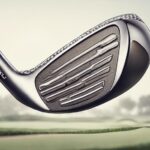- 7 Top Flite Golf Clubs XL for Improved Performance - September 28, 2024
- Top Flite Golf Clubs: Top 5 Reasons to Choose Them - September 28, 2024
- Top 3 Golf Club Fitters for a Perfect Swing - September 28, 2024
When you pick up a golf club, the number on it indicates the loft angle of the clubface, which determines the height and distance of your ball flight. Standard numbering ranges from 1 (driver) to 9 (pitching wedge), with lower-numbered clubs having less loft for longer, lower shots and higher-numbered clubs having more loft for higher trajectories but shorter distances. Understanding the relationship between club numbers and loft is essential for selecting the right club for specific shots, and as you explore the nuances of golf club design, you'll uncover the secrets to optimizing your game and taking your skills to the next level.
Key Takeaways
- Golf club numbers indicate the loft angle of the clubface, with lower numbers having less loft and higher numbers having more loft.
- Standard golf club numbering ranges from 1 (driver) to 9 (pitching wedge), with woods and irons being the primary clubs featuring numbers.
- Lower-numbered clubs produce longer, lower shots, while higher-numbered clubs produce higher trajectories but shorter distances.
- Each club number corresponds to a specific loft angle, affecting shot height and trajectory, making understanding loft crucial for selecting the right club.
What Are Golf Club Numbers?
When you pick up a golf club, you're likely to notice a number emblazoned on the sole or face, but what does this number actually represent? Those numbers on golf clubs aren't just for show; they indicate the loft angle of the clubface, which directly affects the height and distance the ball will travel when struck.
The standard numbering system, ranging from 1 (driver) to 9 (pitching wedge), assigns specific loft angles to each type of club. Lower-numbered clubs, like a 3-iron, have less loft, resulting in longer distances at a lower height, while higher-numbered clubs, like a 9-iron, have more loft, leading to higher trajectories but shorter distances.
As you explore your golf bag, you'll notice that woods and irons are the primary clubs featuring numbers. Woods are designed for longer shots, while irons are used for more precise, shorter shots.
Understanding the relationship between golf club numbers and loft is essential for selecting the appropriate club for different situations on the golf course. By recognizing the significance of these numbers, you'll be better equipped to navigate the course with confidence and precision.
Understanding Loft and Distance
You'll find that the relationship between golf club numbers and loft is vital in determining the distance your ball will travel, as each number corresponds to a specific loft angle that affects the shot's height and trajectory.
Lower-numbered clubs, such as the #3 iron, have less loft, resulting in longer, lower shots, while higher-numbered clubs, like the #9 iron, have more loft for shorter, higher shots.
For instance, a #3 wood typically has a loft ranging from 15 to 18 degrees, whereas a #5 wood has a loft between 20 to 22 degrees, affecting the launch height and distance.
Understanding the loft and corresponding distances associated with each club number is essential for selecting the right club for specific shots.
Irons, in particular, have distinct loft ranges, with #1-#3 irons between 20-25 degrees, #4-#6 irons between 25-30 degrees, and #7-#9 irons between 35-41 degrees.
The Difference Between Woods and Irons
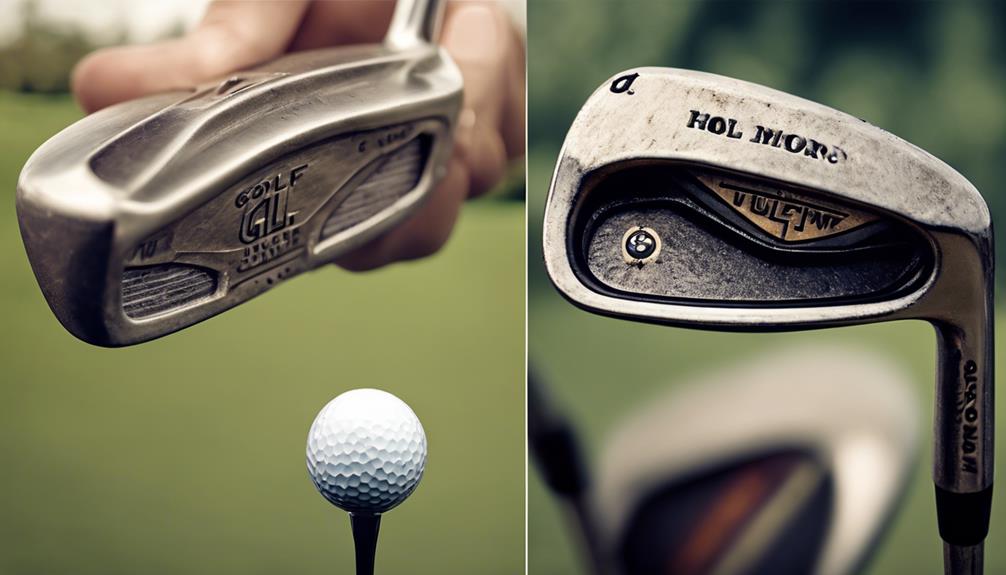
As you move beyond understanding the relationship between golf club numbers and loft, it's clear that clubs fall into two distinct categories: woods and irons, each designed to serve a specific purpose in your game.
Woods and irons differ in design, material, and functionality. Woods have larger, circular club heads optimized for longer-distance shots, while irons feature smaller, angled club heads suited for precision and shorter-range shots.
| Club Type | Loft Range | Typical Use |
|---|---|---|
| Woods | 15-22° | Tee shots, long fairway shots |
| Long Irons | 20-25° | Longer approach shots |
| Mid Irons | 28-33° | Mid-range approach shots |
| Short Irons | 35-41° | Short, accurate approach shots |
Woods are primarily used for tee shots and long fairway shots, while irons are typically used for approach shots and when hitting from the fairway or rough. Understanding the differences between woods and irons will help you choose the right club for your shot, leading to improved accuracy and control in your game.
How Club Numbers Affect Shot Trajectory
Your golf club selection directly influences the trajectory of your shots, with the numbers on your clubs serving as a vital factor in determining the height and distance your ball will travel. The numbers on your clubs indicate the loft angle of the clubface, which in turn affects the shot trajectory.
Lower numbered clubs, such as a 3-iron, have less loft, resulting in a flatter trajectory and longer distance. In contrast, higher numbered clubs, like a 9-iron, have increased loft angles, leading to a steeper trajectory and shorter distance.
For woods, the loft angle also varies with the club number. A 3-wood typically has a loft ranging from 15 to 18 degrees, producing a lower launch angle compared to a 5-wood, which has a loft between 20 to 22 degrees for higher shots.
As the loft increases with higher numbered irons, the launch angle also rises, affecting the carry distance. Understanding what the numbers mean regarding shot trajectory is essential for selecting the appropriate club for different distances and shot types on the golf course.
Choosing the Right Club for Your Game
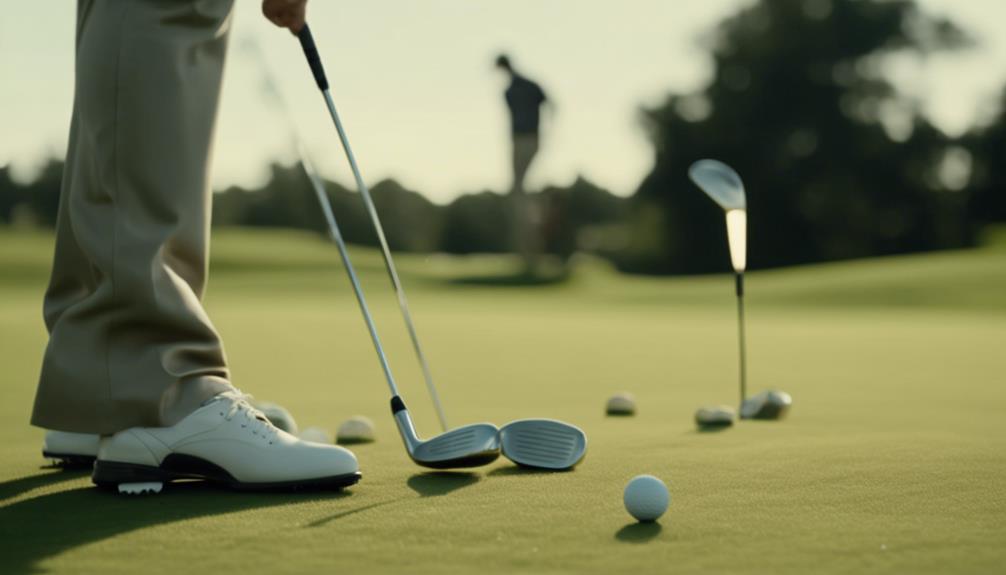
Selecting the right golf club for your game involves more than just understanding the numbers on the clubface; it requires an in-depth exploration of your individual strengths, swing dynamics, and playing style.
You need to experiment with different golf clubs to find what works best for you. For instance, if you're a beginner, you may find the #7 and #8 irons to be user-friendly options that offer a balance of loft and distance.
When choosing a driver, consider your swing speed. If you have a faster swing, a lower loft (e.g., 9.5°) might be suitable, while an average player may benefit from a higher loft (e.g., 10.5° or 12.5°) to achieve ideal launch angles.
Professional fitting can also enhance your club performance by matching the correct loft and shaft flex to your swing dynamics.
By taking the time to understand your game and finding the right golf clubs, you'll be able to enhance your performance and take your game to the next level.
The Role of Physics in Golf Club Design
As you explore the intricacies of golf club design, you'll discover that the clubface angle and loft play a critical role in determining the trajectory of your shot.
By understanding how these factors interact, you can optimize your club selection and swing technique to achieve the desired distance and height.
Now, let's examine the physics behind clubface angle effects and loft's impact on trajectory to reveal the full potential of your game.
Clubface Angle Effects
The clubface angle, denoted by the golf club number, plays an essential role in determining the trajectory and distance of your shot, with subtle variations in loft greatly impacting the ball's flight path.
You'll notice that clubs have numbers, and these numbers directly correlate with the clubface angle effects. For instance, a 3-wood has a loft ranging from 15 to 18 degrees, resulting in a lower flight path compared to a 5-wood, which has a loft of 20 to 22 degrees.
Irons follow a similar pattern, with 1-3 irons having lofts between 20 to 25 degrees, and 7-9 irons ranging from 35 to 41 degrees.
The physics of golf confirms that a higher loft angle increases the ball's launch height but decreases its distance due to air resistance and gravitational forces acting on the ball.
Loft and Trajectory Impact
You'll find that the intricate relationship between a club's loft and trajectory is rooted in the fundamental principles of physics, where the angle of the clubface at impact dramatically influences the ball's flight path and overall distance.
As you explore the nuances of golf club design, you'll notice that loft angle considerably affects trajectory. Lower-numbered clubs, such as 3-woods, typically have lofts between 15-18 degrees, resulting in longer, flatter shots. Conversely, higher-numbered clubs, like 9-irons, have lofts ranging from 35-41 degrees, producing higher, shorter flights.
The physics behind loft and trajectory is straightforward: a club's angle at impact affects the lift and drag forces on the ball, determining how high and far it will travel. A higher loft generally increases lift but often at the expense of overall distance.
By understanding the relationship between club numbers and corresponding lofts, you can make informed decisions on club selection based on your skill level and the specific requirements of each shot on the course.
Mastering this concept will help you optimize your game, as you learn to harness the power of physics to achieve precise control and maximum distance.
Club Selection for Beginners and Pros
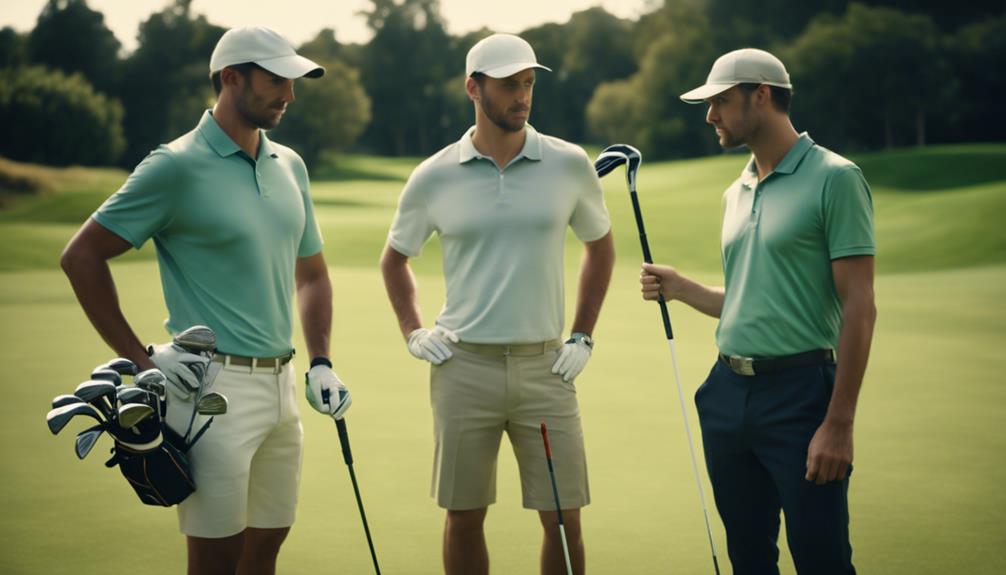
When stepping onto the course, golfers of all levels must deliberately choose the right clubs to tackle specific shots, and for beginners, this decision can make all the difference in improving their overall game.
As a beginner, you'll want to focus on mid-irons like the #7 and #8 irons, which offer a balance of loft and distance, making them user-friendly for improving accuracy and consistency. For better distance control, you'll typically benefit from using lower-numbered clubs like the #3 and #4 irons, which provide less loft and are designed for longer shots.
As you progress in your golf journey, you'll want to evaluate the loft of each club, understanding that lower-numbered clubs (1-4) are best for long-distance shots, while higher-numbered clubs (5-9) are better for approach shots.
Pros often select clubs based on their specific swing speed and playing style, with many opting for adjustable drivers to fine-tune loft and trajectory for peak performance.
Whether you're playing recreational or competitive golf, mastering club selection is key to revealing your full potential on the course.
The Importance of Experimenting With Clubs
By experimenting with different clubs, golfers can gain a deeper understanding of how varying lofts and clubface angles impact shot height and distance, ultimately leading to improved overall performance.
When you test various numbered golf clubs, such as switching between a 7-iron and 9-iron, you'll identify which club provides you with the best control and accuracy for your swing style.
Regular practice with different clubs helps you recognize your strengths and weaknesses, allowing for more informed club selection during actual play. You may discover preferences for specific brands or models that enhance your confidence and comfort on the course.
Using a mix of clubs in practice rounds helps you adapt to different course conditions and shot requirements, ultimately leading to better decision-making during competitive play.
By experimenting with different clubs used in your practice sessions, you'll develop a more nuanced understanding of how to navigate varying course conditions and shot requirements.
This experimentation will enable you to make more informed decisions about which club to use in different situations, leading to improved overall performance.
Famous Golfers' Favorite Golf Clubs
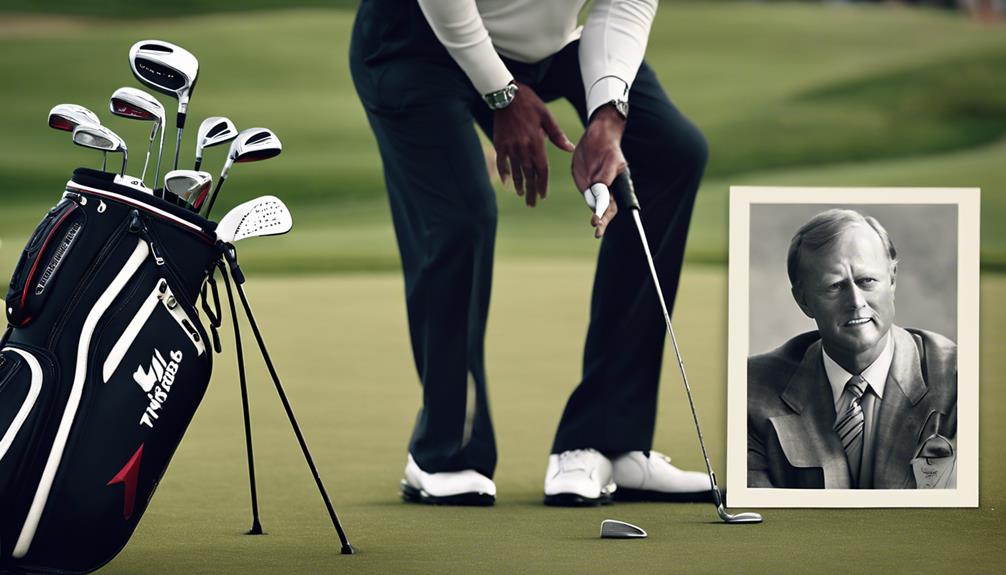
As you explore the world of golf, you'll notice that professional golfers often have a special affinity for specific clubs that have contributed to their success.
You'll soon discover that Tiger Woods, Arnold Palmer, and other golf legends have relied on particular clubs to achieve remarkable feats on the course.
Now, let's examine the significance of Tiger's trusty putter, Arnold's driver secrets, and Bubba's 3-iron magic, and how they can inform your own club selection.
Tiger's Trusty Putter
Tiger Woods' legendary career has been considerably shaped by his trusty Scotty Cameron Newport 2 putter, a club that has become an integral part of his arsenal and a demonstration of the importance of finding the right equipment in golf.
As you prepare to take your own game to the next level, understanding the significance of Woods' putter can be a valuable lesson. This iconic club has contributed to 14 of his 15 major victories, thanks to its classic blade shape that enhances feel and control on the greens.
Woods has customized his putter to fit his specific preferences regarding length, weight, and grip style, showcasing the importance of personal fitting in golf. You can learn from his example by experimenting with different clubs to find what works best for you.
Arnold's Driver Secrets
You're likely familiar with Tiger Woods' trusty putter, but another legendary golfer, Arnold Palmer, wielded a driver that was just as iconic, and its secrets can help you access more distance and accuracy off the tee.
Palmer's mastery of the driver was a key factor in his success on the golf course, and understanding his approach can elevate your game.
Here are the secrets behind Palmer's driver:
- He used a 10-degree driver, which provided an ideal launch angle and distance.
- His go-to driver was the Callaway Big Bertha, known for its forgiving design and distance capabilities.
- Palmer's strong grip and follow-through were essential to his powerful swing style.
- He believed in the importance of practice, saying 'The more I practice, the luckier I get.'
Bubba's 3-Iron Magic
Bubba Watson's mastery of the 3-iron has earned him a reputation as one of the most skilled players in professional golf. His iconic club choice allows him to achieve remarkable distances and accuracy on the course.
You've likely heard of his incredible 366-yard drive during the 2018 Masters Tournament, which showcased the club's incredible potential. What makes Bubba's 3-iron so effective is its unique combination of loft and trajectory control, which allows him to maximize distance while maintaining precision.
Typically, a 3-iron has a loft of around 20 to 25 degrees, making it an ideal choice for skilled players like Bubba who can harness its power. The numbers represent a higher level of golf, where every degree of loft and every yard of distance count.
Applying Golf Club Knowledge on the Course
With a solid grasp of golf club numbers and their corresponding lofts, you can now apply this knowledge on the course to tackle various shots with confidence. You'll be better equipped to hit the ball with precision, taking into account the maximum number of yards you need to cover.
Here are some key considerations to keep in mind when applying your golf club knowledge on the course:
- Experiment with different clubs to find the ones that feel most comfortable for you, and practice with them regularly to build consistency and confidence.
- Consider your individual skill level and swing dynamics when selecting clubs, as this can greatly affect performance and shot outcomes.
- Think about the loft of the club and how it will influence the trajectory of your shot. For example, a 7-iron with a loft of around 34-36 degrees is ideal for approach shots to the green.
- Don't be afraid to try out different clubs in different situations to see what works best for you.
Frequently Asked Questions
How Do You Read Golf Club Numbers?
You read golf club numbers by understanding the club numbering system, which indicates loft angle and affects distance control; lower numbers mean less loft and longer distances, while higher numbers offer more loft for higher shots.
How Do I Choose a Golf Club Number?
When choosing a golf club number, you'll want to reflect on club selection tips, such as understanding lofts, to determine the right fit for your swing; assess your distance, speed, and style to select the ideal club for each shot.
What Do the Numbers 1 2 3 4 Mean on Golf Balls?
You might think golf ball numbers are just for show, but they hold significant meaning! The numbers 1, 2, 3, and 4 on golf balls indicate compression rating, with lower numbers suited for slower swing speeds and higher numbers for maximum performance.
How Do I Know What Golf Club to Use?
When evaluating your golf club selection, you'll need to assess the club distance evaluation, considering factors like target distance, swing speed, and loft to choose the right club, ensuring ideal performance and accuracy in your game.
Conclusion
You've now mastered the world of golf club numbers, and it's time to put your knowledge into practice.
Remember, choosing the right club can make all the difference in your game.
Take the example of professional golfer, Rory McIlroy, who switched to a 9-degree driver at the 2019 Players Championship, resulting in a 10-shot improvement from his previous round.
By understanding club numbers, you can make similar adjustments to elevate your game and start winning.

